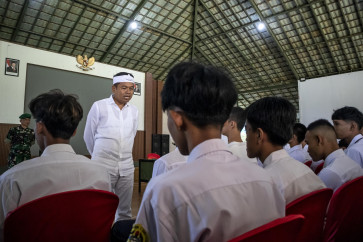Popular Reads
Top Results
Can't find what you're looking for?
View all search resultsPopular Reads
Top Results
Can't find what you're looking for?
View all search resultsJobs bloom from garbage at Bantar Gebang dump
Wait your turn: Orange garbage trucks from the Jakarta Sanitation Agency line up to dump their load at Zone II of the Bantar Gebang landfill in Bekasi, West Java, while excavators heap garbage onto a hill
Change text size
Gift Premium Articles
to Anyone

W
ait your turn: Orange garbage trucks from the Jakarta Sanitation Agency line up to dump their load at Zone II of the Bantar Gebang landfill in Bekasi, West Java, while excavators heap garbage onto a hill. (JP/Norman Harsono)
Asih frantically prepares two iced teas in a plastic bag, while another customer orders three iced coffees and three fried snacks. She has a half-empty trunk of crushed ice by her side and 9 gallons of fresh water beside her stall that stands on a landfill.
“This landfill is really a treasure chest [...] as long as you’re willing to get smelly,” she joked.
Asih is one of the hundreds of individuals who earn a living from the Bantar Gebang Integrated Waste Treatment Area (TPST Bantar Gebang) in Bekasi, West Java.
Jakarta has been dumping its garbage in this 110-hectare landfill, which is almost as wide as the Gelora Bung Karno sports complex in Central Jakarta, since 1989. This massive dump is divided into five zones and each zone has a range of colorful hills of garbage up to 10 stories tall. Most of the garbage is organic waste, followed by plastics and paper.
The garbage hills of Zone I are covered with a thick, black tarpaulin that collects biogas to generate electricity. The remaining zones remain open landfills receiving around 6,000-7,000 tons of garbage every day.
Asih’s makeshift wooden kiosk is on the northwestern side of Zone V. She has been selling drinks solo from 5 a.m. to 5 p.m. in Bantar Gebang for five years, serving the hundreds of scavengers that forage the hills of Zone V for recyclable materials.
She gets around Rp 1 million per day in revenue from selling simple beverages, pre-packed lunches and assorted deep-fried snacks.
But she is under constant threat of being thrown out by the landfill’s security staff.
“Security has been vicious ever since Jakarta took over,” she complained, referring to the increase of regulations and evictions ever since the the management was taken over from PT Godang Tua Jaya in July 2016.
“They were throwing out sellers almost every other day when Jakarta first took over,” Asih adds.
She had to stop working for a week before she dared to start selling again, while trying to hide from security. At one point she did not even have a kiosk and sold drinks directly under the sun.
“As long as I can keep selling,” she declared. “It’s up to our wit.”
She said she wished Jakarta would let her work in peace, or at least give an early warning if an inspection is planned so she can remove all her goods.
Her business is unaffected by the fasting season as the heat and the work is too grueling for the scavengers to fast. Her stall gets particularly crowded around noon as the scavengers take a break.
Daniti is among her regular customers. She and her husband have been scavenging in Bantar Gebang since it first opened.
Her work involves scavenging for freshly-dumped plastic and paper, separating out the recyclable products, then selling them to recycling plants.
She starts work around 7 a.m., trudging about the landfill with a curved pick used to toss trash into the wicker basket worn on her back. When the basket is full, she packs the trash into a white canvas sack, stores it by the side of the road, and returns to scavenging. The heavier the sacks, the more money she gets.
Throughout this process, she is at constant risk of being knocked down by an excavator, stepping into pools of acidic waste water, burned by a methane gas explosion, or swallowed by a garbage landslide.
“What else can I do?” she commented. “We’re poor.”
Daniti and her husband earn an average of Rp 1 million in revenue per week, but this has decreased over the past few months due to the dropping price of paper and the dry season reducing the weight of their sacks.
Their income is supposed to be supplemented by Rp 200,000 in monthly compensation from Jakarta, literally called the ‘smelly money’, but it has not come for the last three months.
Daniti is also a housewife and grandmother. She wakes up at dawn every day, washes the dishes, washes the clothes, then walks about 15 minutes to the landfill to begin work.
“I used to cook as well, but now I let my daughter-in-law do it,” she jests.
She explained that many older women had to help their scavenger husbands to make ends meet. Only women with young children, such as her daughter-in-law, or other who take care of young children, stay at home.
She also mentioned how some male teenagers earn money by helping open and close the back door of garbage trucks. They are referred to as “Anak Gulung Tikar” and earn Rp 5,000 per truck.
Daniti and her husband finish scavenging around 4 p.m. and start loading all their sacks of garbage into a rented pick-up truck for transportation to the back of their house. They accumulate sacks until there are enough to fill a pick-up truck, which takes about a week. The trash is then transported to a recycling plant.
Jamaluddin is a pick-up truck driver. He can do 2 to seven trips a day, earning at least Rp 700,000.
However, Jamaluddin’s journey to becoming a truck owner was not easy. He left his home island of Madura at 14 years old and began working at drying plastic bags in a landfill.
Consequently, he never went to school and is often sneered at whenever he goes to a bank and struggles to write.
Jamaluddin grew older and then became a scavenger, earning only a third of what he earns now, yet he kept working until he earned enough to take out a loan on the pickup truck.
“What’s important for me is to be healthy so I can keep working,” he said.
Jamaluddin now lives with his wife and one child in a house on rented land only a 15-minute walk from the landfill.
His next-door neighbors, Daniti and Denin, return home at around five in the evening.
Even after a long day of scavenging, Daniti still spares her time to cook a simple dinner and chat with other village women.
Daniti only wishes that her children will live a better life than her.
“I’m already old, where else can I go?” she jokes. “That’s why I ask Astri [the youngest child] to go to school so at least she can read and write. I don’t want her to work here but at least to work in a factory. Don’t be like her mother. I can’t work anywhere else.”
__________________________________________________
Live-In Experience is part of the two-month tutorial and on-the-job-training sessions provided for young journalists of The Jakarta Post as part of its recruitment and training program. Participants are attached with selected families of the less fortunate in order to provide them with the direct experience of living with the frequently forgotten segment of Indonesian society. Istu Septania and Norman Harsono spent their two nights and three days living with two different families at the Bantar Gebang dumpsite neighborhood in Bekasi, a suburb of Jakarta.









